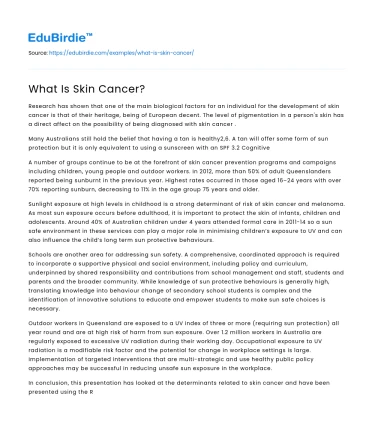Research has shown that one of the main biological factors for an individual for the development of skin cancer is that of their heritage, being of European decent. The level of pigmentation in a person's skin has a direct affect on the possibility of being diagnosed with skin cancer .
Many Australians still hold the belief that having a tan is healthy2,6. A tan will offer some form of sun protection but it is only equivalent to using a sunscreen with an SPF 3.2 Cognitive
Save your time!
We can take care of your essay
- Proper editing and formatting
- Free revision, title page, and bibliography
- Flexible prices and money-back guarantee
A number of groups continue to be at the forefront of skin cancer prevention programs and campaigns including children, young people and outdoor workers. In 2012, more than 50% of adult Queenslanders reported being sunburnt in the previous year. Highest rates occurred in those aged 16–24 years with over 70% reporting sunburn, decreasing to 11% in the age group 75 years and older.
Sunlight exposure at high levels in childhood is a strong determinant of risk of skin cancer and melanoma. As most sun exposure occurs before adulthood, it is important to protect the skin of infants, children and adolescents. Around 40% of Australian children under 4 years attended formal care in 2011-14 so a sun safe environment in these services can play a major role in minimising children’s exposure to UV and can also influence the child’s long term sun protective behaviours.
Schools are another area for addressing sun safety. A comprehensive, coordinated approach is required to incorporate a supportive physical and social environment, including policy and curriculum, underpinned by shared responsibility and contributions from school management and staff, students and parents and the broader community. While knowledge of sun protective behaviours is generally high, translating knowledge into behaviour change of secondary school students is complex and the identification of innovative solutions to educate and empower students to make sun safe choices is necessary.
Outdoor workers in Queensland are exposed to a UV index of three or more (requiring sun protection) all year round and are at high risk of harm from sun exposure. Over 1.2 million workers in Australia are regularly exposed to excessive UV radiation during their working day. Occupational exposure to UV radiation is a modifiable risk factor and the potential for change in workplace settings is large. Implementation of targeted interventions that are multi-strategic and use healthy public policy approaches may be successful in reducing unsafe sun exposure in the workplace.
In conclusion, this presentation has looked at the determinants related to skin cancer and have been presented using the Red Lotus health model. We thank you for your time.






 Stuck on your essay?
Stuck on your essay?

